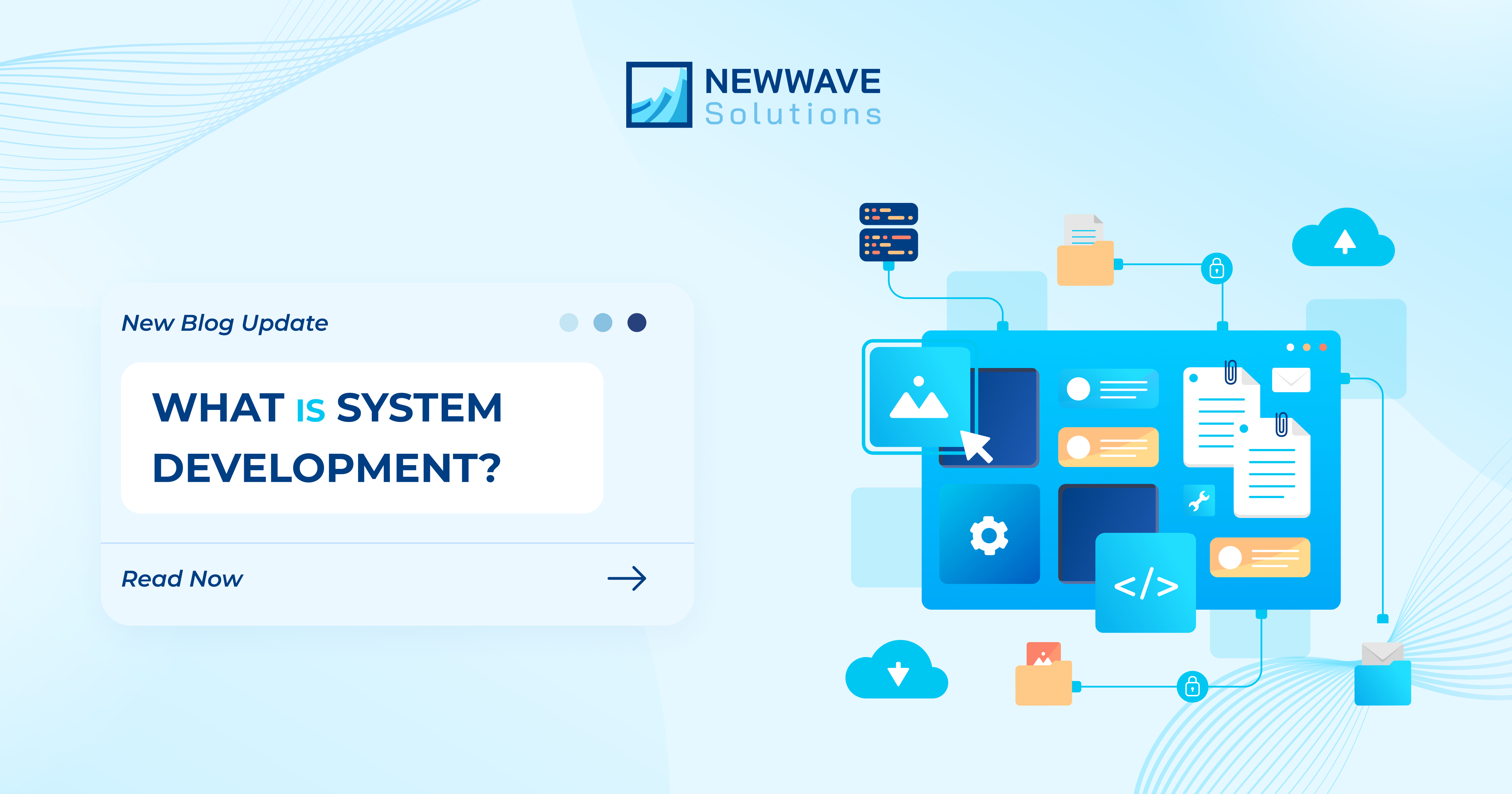

Everything You Need to Know about System Development

Whether it’s upgrading to new hardware, designing software, or expanding your market, system development plays a crucial role in every business. However, through iterative processes and changing business demands, it can be different depending on the nature of each project. Read on to know more about system development and how it can benefit your business.
Table Of Contents
ToggleWhat is System Development?
Before digging into the definition of system development, you might want to know exactly what the system is. System or system software is a computer program that is designed to run the hardware and apps while also maintaining your computer’s basic functions. Imagine the computer system is like a layered model, then the system is the interface between hardware and applications. For instance, an operating system (OS) such as iOS is the best-known example of system software.
So, in simple words, system development is the process of creating a program from scratch. However, even though writing code is the core activity of system development, it’s much more than that. Explore more about it with us below!
Difference Between System Software Development & Application Software Development
Since both are a type of software, these two are easy to misunderstand. Unlike system software, application software or apps performs a particular function for the end user. Here are the key differences between system software development and application software development:
| System software development | Application software development |
| – General-purpose software that manages basic system resources and processes – Written in low-level assembly language or machine code – Must meet specific hardware needs – Installed at the same time as the OS – Runs in the background and users don’t usually access it- Runs independently |
– Software that performs specific tasks to meet user needs – Written in higher-level languages like Python & JavaScript – Doesn’t take hardware into account and doesn’t interact directly with hardware – Runs in the foreground – Needs system software to run |
System Development Life Cycle (SDLC)

Whether you want to apply this system development life cycle to your entire project or just for one feature, SDLC helps reduce risk by shortening the length of each step in system development. In most cases, most system developers will stick with these 5 basic phases:
1. Planning
- Confirm project feasibility and schedule.
- Define the problem/scope if it’s an existing system.
- Review the plan for your new system and determine its objectives.
- Consider features like constraints, threats, integration, and security.
2. Analysis
- Gather, analyze, and validate the information/consultations from experts.
- Evaluate the alternatives and prioritize the requirements.
- Examine the information needs of your end-user to enhance the system goal.
- Prepare a software requirement specification (SRS) document.
3. System Design
- Design your application, network, databases, user interfaces (UI/UX), and system interfaces.
- Transform the SRS document into a logical structure, which contains a detailed and complete set of specifications.
- Create a contingency, training, maintenance, and operation plan.
- Review to ensure that the final design must meet the requirements stated in the SRS document.
4. Implementation
- Implement the design into your source code and combine all the modules together.
- Prepare a test report that contains all errors through test case generation, testing criteria, and resource allocation for testing.
- Integrate the information system into its environment and install the new system.
5. Maintenance
- Mobile support or on-site support for users is required once the system is installed.
- Implant changes or new updates that your system might undergo over time.
- Handle the residual errors and resolve any issues that may exist in the system even after the testing phase.
- Maintenance and support are needed in the future, especially for large systems.
Why Do Your Businesses Need System Development?
From sales, payroll, to any operational activities, you can implement systems across multiple areas in your business to bring great benefits. Below are some reasons why you should
- Improve Top-Line Performance: Fundamental elements like strategy creation and business processes lead to a much more insightful way to investigate and grow top-line revenue. In short, system development ensures you meet your customer’s expectations and improve your branding, which is key to growing a healthy business.
- Meet Customer’s Expectations: You can easily get critical information on business areas that need to be improved. Plus, some unmet needs can be discovered if you apply the right method with system development.
- Consistent Results: Whether you’re considering safety, quality, or development cost, a business system is designed to give you effective and repeatable results. In short, it is a process to fix your processes!
- Employee Engagement: The system’s goal is to provide opportunities for all employees so they can complete their work more in the most efficient way. Additionally, having a system in place allows your company to quickly integrate new employees and makes it easy for them to see their role within the organization.
- Reduce Cost and Increase Profits: It has been proven that system development helps reduce costs since forever! Developing a business system is actually a way to cut costs without taking the shortcut that often leads to lower quality products or service levels.
Top 5 System Development Methodologies 2022
Selecting the right system development methodology for your project depends largely on your team size, goals, and your requirements. So, let’s take a look at the top 5 system development methodologies to help you decide which is right for your project!
Agile
Agile software development is a customer-friendly approach that is used to design complicated systems and apps with a focus on flexibility and security. With Agile methodology, users have the opportunity to make modifications based on their business context and customer demand. It not only offers a customer-friendly approach but also ensures high-quality outcomes. Additionally, there are many different forms of the agile development method, including extreme programming (XP), scrum, and FDD.
What makes Agile a unique method:
- Superior quality product
- Customer satisfaction
- Frequent incremental improvements
- Improved project predictability
- Reduced risks
- Increased flexibility
DevOps
DevOps is not just a development methodology but a set of practices that combines software development and IT operations. It strives to shorten the systems development process and provide continuous delivery with high software quality. DevOps is focused on reducing development time while also lowering the failure rate of new releases and maximizing reliability.
What makes DevOps a unique method are:
- Reducing time to market
- Customer satisfaction
- Good efficiency
RAD
Rapid application development (RAD) is a development model that produces a high-quality system with low investment costs. RAD method contains 4 phases: requirements planning, user design, construction, and cutover. It allows developers to quickly adjust to meet your business requirements in this constantly changing market. This ability is what makes RAD a quite cost-efficient methodology.
What makes RAD a unique method:
- Quicker adjustments
- Fewer errors
- Lower maintenance costs
- Faster release of versions
- Better adoption of new technologies
Waterfall
It is considered one of the most traditional software development methods. The Waterfall methodology is a rigid linear model that consists of sequential phases which include requirements, design, implementation, verification, and maintenance. Each one must be completed so the next phase can start. There’s usually no process for going back to modify the project or direction when using Waterfall.
What makes Waterfall a unique method:
- Transfers information well
- Easy to understand and manage
- Best for clear objectives and stable requirements
- Uses a clear structure
Prototyping Model
With this method, the prototype is the core of the system development. It is a system developed in which a prototype is built, tested, and reworded until the final result is achieved. Prototyping model works best in situations where the project requirements are not known in detail. It is a trial and error method that takes place between clients and software programmers.
What makes Prototyping Model a unique method are:
- Clients can actively be involved in development.
- Prototype reduces the risk.
- Enhance effective communication among the team
- Early user feedback helps to develop better software solutions.
Should You Choose Software Outsourcing for System Development?
In simple words, software outsourcing or system development outsourcing is when an organization chooses to hire a software development outsourcing company to carry out its digital task. According to research from Statista, the IT industry has the biggest outsourced field among all with over 413.7 billion U.S Dollars worth of value by the end of 2021. Such statistics clearly prove that the software development market is on the rise and the method is trusted and widely used by many corporations and businesses.
All of that makes software outsourcing services a great strategy to start for businesses during this challenging time. Below are some reasons why you should consider hiring a software outsourcing company for system development:
- Cost savings. The system development cost varies quite significantly depending on where your IT service is. The best place to get a cost-effective rate with decent development quality is from Asian countries like Vietnam, India, or Philippines.
- Cutting-edge technologies. A software development company is always equipped with the latest emerging technologies to increase its efficiency.
- High productivity. Since you’re working with an experienced IT team, you don’t have to spend too much time managing or dealing with any issue in the project. Plus, you can use this time to focus on other important aspects of your business.

Final Thoughts
Overall, systems development is a process of defining, designing, testing, and implementing new software or program. A digital system makes a business purchase more enticing and valuable thanks to its tangible assets. Those who can follow a system effectively will find themselves a good place on the market and ensure a victory against their competition. You can either choose to develop your system software with an in-house team which can be quite time-consuming if your IT developers are new or hire an outsourcing system development company for a more cost-effective and efficient approach.
If you’re finding a system development company, Newwave Solutions can produce high-quality systems that meet every of our customer’s requirements. By delivering a robust system within scheduled time frames and cost estimates, we ensure that your business will benefit a lot from this new system software. At Newwave Solutions, we apply the latest technology like Agile methodologies which focus on lightweight processes and allow rapid changes along the development. Our approach is designed to ensure end-state solutions that meet our client’s needs to support every of their business goals and objectives.
Contact us today to discuss your system development project and get free consultations from us!
Tags
To Quang Duy is the CEO of Newwave Solutions, a leading Vietnamese software company. He is recognized as a standout technology consultant. Connect with him on LinkedIn and Twitter.
Popular News
- What is System Development?
- Difference Between System Software Development & Application Software Development
- System Development Life Cycle (SDLC)
- Why Do Your Businesses Need System Development?
- Top 5 System Development Methodologies 2022
- Should You Choose Software Outsourcing for System Development?
- Final Thoughts
Related News
-

-
 Managing Offshore Teams: Best Practices for SuccessFebruary 5, 2025 View more
Managing Offshore Teams: Best Practices for SuccessFebruary 5, 2025 View more -
 Top 10 Best Offshore Software Development Countries in 2025January 27, 2025 View more
Top 10 Best Offshore Software Development Countries in 2025January 27, 2025 View more












